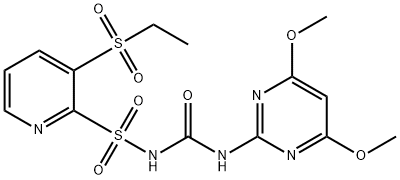Description
Rimsulfuron is an herbicide for the treatment of annual broadleaf weeds, certain grasses and perennial broadleaf weeds. It is quite effective in the treatment of glyphosate-resistant weed species such as marestail/horseweed. Its mechanism of action is through inhibiting the acetolactate synthase (ALS), which is involved in the synthesis of isoleucine, leucine and valine of plant, further blocking protein synthesis and the growth of weeds.
Reference
- Rathinasabapathi, Bala. "Physiological Basis for Differential Tolerance of Tomato and Pepper to Rimsulfuron and Halosulfuron: Site of Action Study." Weed Science 52.2(2004):201-205.
- Schneiders, G. E., et al. "Fate of rimsulfuron in the environment. " Journal of Agricultural & Food Chemistry 41.12(1993): 2404-2410.
- Ackley, John A., and T. E. Hines. "Efficacy of Rimsulfuron and Metribuzin in Potato (Solanum tuberosum)." Weed Technology 10.3(1996):475-480.
- Koeppe, M. K., et al. "Basis of Selectivity of the Herbicide Rimsulfuron in Maize ☆." Pesticide Biochemistry & Physiology 66.3(2000):170-181.
Uses
Rimsulfuron is used as a pesticide.
Definition
ChEBI: A N-sulfonylurea that is N-carbamoyl-3-(ethylsulfonyl)pyridine-2-sulfonamide substituted by a 4,6-dimethoxypyrimidin-2-yl group at the amino nitrogen atom.
Agricultural Uses
Herbicide: For controlling broadleaf weeds. Registered for use in the U.S. and Canada. A U.S. EPA restricted Use Pesticide (RUP) for some formulations. Registered for use in some EU countries.
Trade name
ACCENT®; BASIS® (rimsulfuron+thifensulfuron methyl); DPX-E9636®; DPX 79406® (nicosulfuron+rimsulfuron); Matrix® (nicosulfuron+rimsulfuron); SHADEOUT®; STEADFAST®, (nicosulfuron+rimsulfuron); TRANXIT®
Metabolic pathway
The primary degradation pathway in most of the
systems examined is the contraction or
rearrangement and hydrolysis of the sulfonylurea
linkage to yield two products that have N-pyridyl-N-
pyrimidyl urea and N-pyridyl-N-pyrimidylamine
moieties, and fragments of pyridine sulfonamide, 4,6-
dimethoxy-2-pyrimidylurea, and 4,6-dimethoxy-2-
amino-pyrimidine, respectively. In plants,
demethylation and hydroxylation reactions follow the contraction or rearrangement to give N-3,4-dihydroxy-
5-methoxy-2-pyrimidyl-N(3-ethylsulfonyl-2-
pyridyl)amine.



